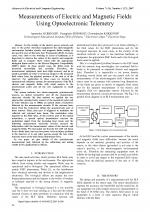| 1/2007 - 6 |
Measurements of Electric and Magnetic Fields Using Optoelectronic TelemetryKOKKOSIS, A., SINIOROS, P., KOKKONIS, C. |
| Extra paper information in |
| Click to see author's profile in |
| Download PDF |
Author keywords
No keywords available
References keywords
References keywords will be displayed on the next page reload.
About this article
Date of Publication: 2007-04-02
Volume 7, Issue 1, Year 2007, On page(s): 26 - 28
ISSN: 1582-7445, e-ISSN: 1844-7600
Digital Object Identifier: 10.4316/AECE.2007.01006
Web of Science Accession Number: 000259841200006
Abstract
In the vicinity of the electric power network and near to the power electrical equipments the electromagnetic environment includes electric and magnetic fields, mainly at the spectral area of Extreme Low Frequencies (ELF). In some cases, very close to the working or areas of habitants, it is important to observe the values of the electric and magnetic fields and to compare those values with the appropriate biological limits and/or to the Electro-Magnetic Compatibility (EMC) limits. In these special cases the fields must be measured successfully and carefully. Therefore, the measurement equipment must have high accuracy and be as small as possible, in order to avoid any impact to the measured field values from the physical presence of the unit or of the observer. For application in these cases we develop an optoelectronic telemetry system, for measurements, of the ELF electric and magnetic fields, with small sensors in the measurement point and all the rest equipment in small distance. The system includes two electro-magnetic optoelectronic sensors, an optical transceiver and all the measurement electronic circuits. By that method we applied the two appropriate optoelectronic sensors at the measured point and in some distance (up to 100m) an optical (laser) transceiver followed by the measurement circuits. If the outcome laser beam from the transceiver strikes the optoelectronic part of these sensors. Then, that part is triggered to modulate the reflected and returned laser beam. The modulation value depends on the field value. At the receiver part of the optical transceiver, a special optical demodulator extracts the modulation signal from the incoming laser beam and the following measurement electronic circuits extracts the information with the measurement values of the electric and magnetic fields. We must point out that the few mW red beam from a diode laser, has very low power to be an injury problem to the observer or to any other person, except the case when someone stares at the laser beam (intrabeam view). In our paper we give details of the optoelectronic measurement unit, followed by the calibrating and testing results in two applications in Athens. |
| References | | | Cited By |
Web of Science® Times Cited: 0
View record in Web of Science® [View]
View Related Records® [View]
Updated today
We were unable to retrieve information about this paper in SCOPUS®.
Message: [Returned results: 0]
There are no citing papers in the CrossRef Cited-by Linking system.
Disclaimer: All information displayed above was retrieved by using remote connections to respective databases. For the best user experience, we update all data by using background processes, and use caches in order to reduce the load on the servers we retrieve the information from. As we have no control on the availability of the database servers and sometimes the Internet connectivity may be affected, we do not guarantee the information is correct or complete. For the most accurate data, please always consult the database sites directly. Some external links require authentication or an institutional subscription.
Web of Science® is a registered trademark of Clarivate Analytics, Scopus® is a registered trademark of Elsevier B.V., other product names, company names, brand names, trademarks and logos are the property of their respective owners.
Faculty of Electrical Engineering and Computer Science
Stefan cel Mare University of Suceava, Romania
All rights reserved: Advances in Electrical and Computer Engineering is a registered trademark of the Stefan cel Mare University of Suceava. No part of this publication may be reproduced, stored in a retrieval system, photocopied, recorded or archived, without the written permission from the Editor. When authors submit their papers for publication, they agree that the copyright for their article be transferred to the Faculty of Electrical Engineering and Computer Science, Stefan cel Mare University of Suceava, Romania, if and only if the articles are accepted for publication. The copyright covers the exclusive rights to reproduce and distribute the article, including reprints and translations.
Permission for other use: The copyright owner's consent does not extend to copying for general distribution, for promotion, for creating new works, or for resale. Specific written permission must be obtained from the Editor for such copying. Direct linking to files hosted on this website is strictly prohibited.
Disclaimer: Whilst every effort is made by the publishers and editorial board to see that no inaccurate or misleading data, opinions or statements appear in this journal, they wish to make it clear that all information and opinions formulated in the articles, as well as linguistic accuracy, are the sole responsibility of the author.



